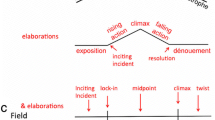Abstract
This paper examines various claims by Noël Carroll about narrative closure and its relationship to narrative connections, which are, roughly, causal connections generously conceived to include necessary conditions for sufficient conditions for an effect. I propose supplementing the expanded notion of a cause with Michael Bratman’s notion of a psychological connection to account for the particular role that human agents play in narratives. A novel and a film are used as examples to illustrate how the concept of a psychological connection eliminates the need for Carroll's condition that narratives must be globally forward-looking.
Similar content being viewed by others
Notes
Carroll (2001), p. 126.
It is worth noting that what Peter Lamarque calls “narratives” are what White and Carroll call “chronicles” (so one can understand why Lamarque thinks narratives, per se, do not account for much). See Lamarque (2004), p. 400, “[A]ll that narratives have in common are minimal formal conditions about the ordering of events in a story.”
There is an interesting question about the role of representations of facts or states of affairs, as opposed to events. Normally, facts are crucial to narrative, though one may be able to conjure peculiar cases where nothing is related but events. Further exploration of these issues is, however beyond the scope of this paper.
Presumably a sufficient condition for a necessary condition for an effect could also be a narrative connection, as well as a necessary condition for a necessary condition for an effect.
This concept is borrowed from Gordon (1987), chapter four, who refers to them as “epistemic emotions.” I have changed the terminology because I do not endorse certain aspects of the concept as Gordon describes it, such as his view that the emotions in question lead one to act as if one believed that what one is uncertain about is in fact true. See, for example, pp. 65–68.
Some feelings are connected with more general attitudes or moods. For example, constant fearfulness may be due to a generalized anxiety disorder; one may be generally irritable or melancholy. No single explanation will account for the myriad feelings, emotions, moods and other affective phenomena that exist.
My intention is only to highlight only one aspect of this complicated issue.
Bratman (2000), p. 44.
Bratman (2000), pp. 45–46.
Bratman (2000), p. 46.
Bratman (2000), p. 47.
Tversky (2004), indicates that “event segmentation” in temporal narratives tends to be in terms of “objects and actions taken on them,” p. 390. Films of a series of geological events could meaningfully be run in reverse without a need to segment the action.
I thank Noël Carroll for suggesting this example.
Carroll (2001).
Wollheim (1987), especially chapter two.
References
Amis, M. (1991). Time’s arrow, or the nature of the offense. New York: Random House, Vintage International.
Bratman, M. (2000). Reflection, planning, and temporally extended agency. Philosophical Review, 109, 35–61.
Carroll, N. (2001). On the narrative connection. In Beyond aesthetics: Philosophical essays (pp. 118–132). New York: Cambridge University Press.
Gordon, R. (1987). The structure of emotions: Investigations in cognitive philosophy. New York: Cambridge University Press.
Lamarque P. (2004). On not expecting too much from narrative. Mind and Language, 19, 393–408.
Tversky, B. (2004). Narratives of space, time, and life. Mind and Language, 19, 380–392.
Vonnegut, K. Jr. (1969). Slaughterhouse-five, or the children’s crusade, a duty-dance with death. New York: Dell.
Wollheim, R. (1987). Painting as an art. Princeton University Press.




